engine oil SUZUKI GRAND VITARA 2016 User Guide
[x] Cancel search | Manufacturer: SUZUKI, Model Year: 2016, Model line: GRAND VITARA, Model: SUZUKI GRAND VITARA 2016Pages: 482, PDF Size: 21 MB
Page 140 of 482
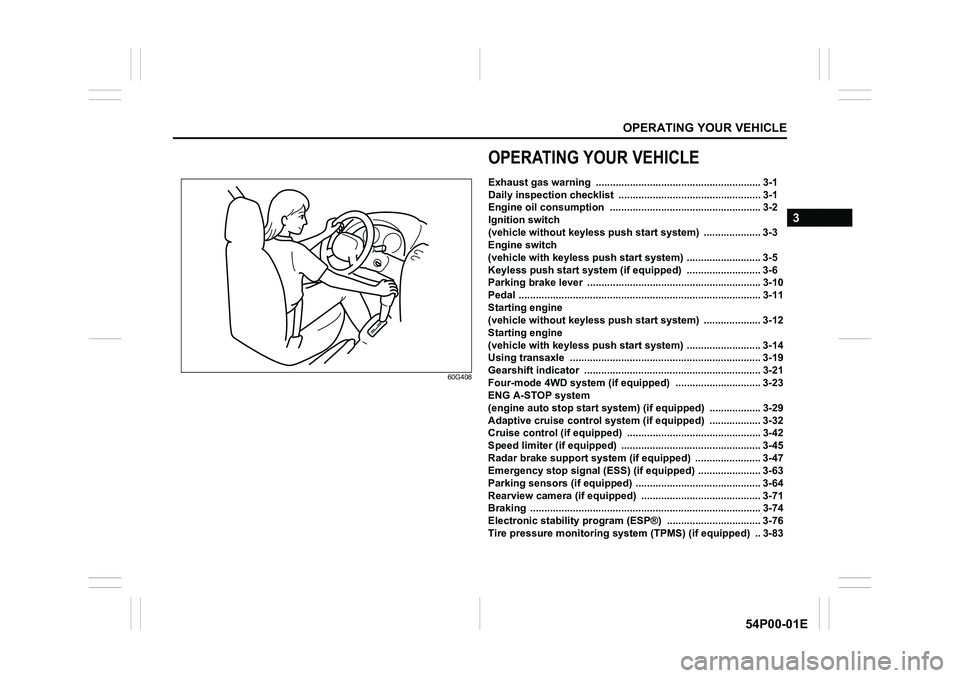
OPERATING YOUR VEHICLE
3
54P00-01E
60G408
OPERATING YOUR VEHICLE
Exhaust gas warning .......................................................... 3-1
Daily inspection checklist .................................................. 3-1
Engine oil consumption ..................................................... 3-2
Ignition switch
(vehicle without keyless push start system) .................... 3-3
Engine switch
(vehicle with keyless push start system) .......................... 3-5
Keyless push start system (if equipped) .......................... 3-6
Parking brake lever ............................................................. 3-10
Pedal ..................................................................................... 3-11
Starting engine
(vehicle without keyless push start system) .................... 3-12
Starting engine
(vehicle with keyless push start system) .......................... 3-14
Using transaxle ................................................................... 3-19
Gearshift indicator .............................................................. 3-21
Four-mode 4WD system (if equipped) .............................. 3-23
ENG A-STOP system
(engine auto stop start system) (if equipped) .................. 3-29
Adaptive cruise control system (if equipped) .................. 3-32
Cruise control (if equipped) ............................................... 3-42
Speed limiter (if equipped) ................................................. 3-45
Radar brake support system (if equipped) ....................... 3-47
Emergency stop signal (ESS) (if equipped) ...................... 3-63
Parking sensors (if equipped) ............................................ 3-64
Rearview camera (if equipped) .......................................... 3-71
Braking ................................................................................. 3-74
Electronic stability program (ESP®) ................................. 3-76
Tire pressure monitoring system (TPMS) (if equipped) .. 3-83
Page 141 of 482
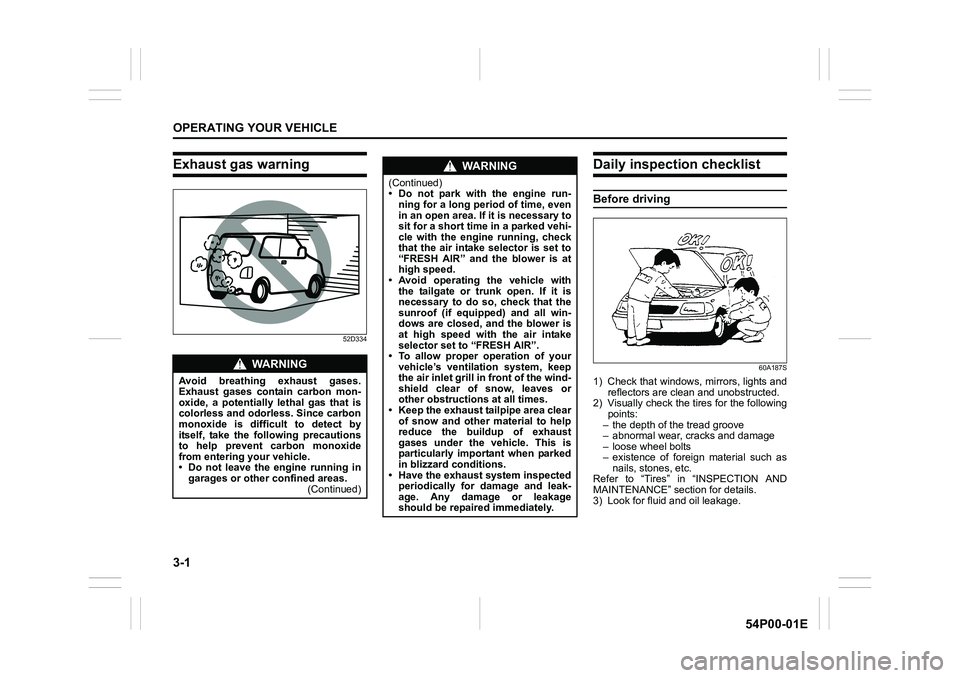
3-1
OPERATING YOUR VEHICLE
54P00-01E
Exhaust gas warning
52D334
Daily inspection checklist
Before driving
60A187S
1) Check that windows, mirrors, lights and
reflectors are clean and unobstructed.
2) Visually check the tires for the following
points:
– the depth of the tread groove
– abnormal wear, cracks and damage
– loose wheel bolts
– existence of foreign material such as
nails, stones, etc.
Refer to “Tires” in “INSPECTION AND
MAINTENANCE” section for details.
3) Look for fluid and oil leakage.
WA R N I N G
Avoid breathing exhaust gases.
Exhaust gases contain carbon mon-
oxide, a potentially lethal gas that is
colorless and odorless. Since carbon
monoxide is difficult to detect by
itself, take the following precautions
to help prevent carbon monoxide
from entering your vehicle.
• Do not leave the engine running in
garages or other confined areas.
(Continued)
WA R N I N G
(Continued)
• Do not park with the engine run-
ning for a long period of time, even
in an open area. If it is necessary to
sit for a short time in a parked vehi-
cle with the engine running, check
that the air intake selector is set to
“FRESH AIR” and the blower is at
high speed.
• Avoid operating the vehicle with
the tailgate or trunk open. If it is
necessary to do so, check that the
sunroof (if equipped) and all win-
dows are closed, and the blower is
at high speed with the air intake
selector set to “FRESH AIR”.
• To allow proper operation of your
vehicle’s ventilation system, keep
the air inlet grill in front of the wind-
shield clear of snow, leaves or
other obstructions at all times.
• Keep the exhaust tailpipe area clear
of snow and other material to help
reduce the buildup of exhaust
gases under the vehicle. This is
particularly important when parked
in blizzard conditions.
• Have the exhaust system inspected
periodically for damage and leak-
age. Any damage or leakage
should be repaired immediately.
Page 142 of 482
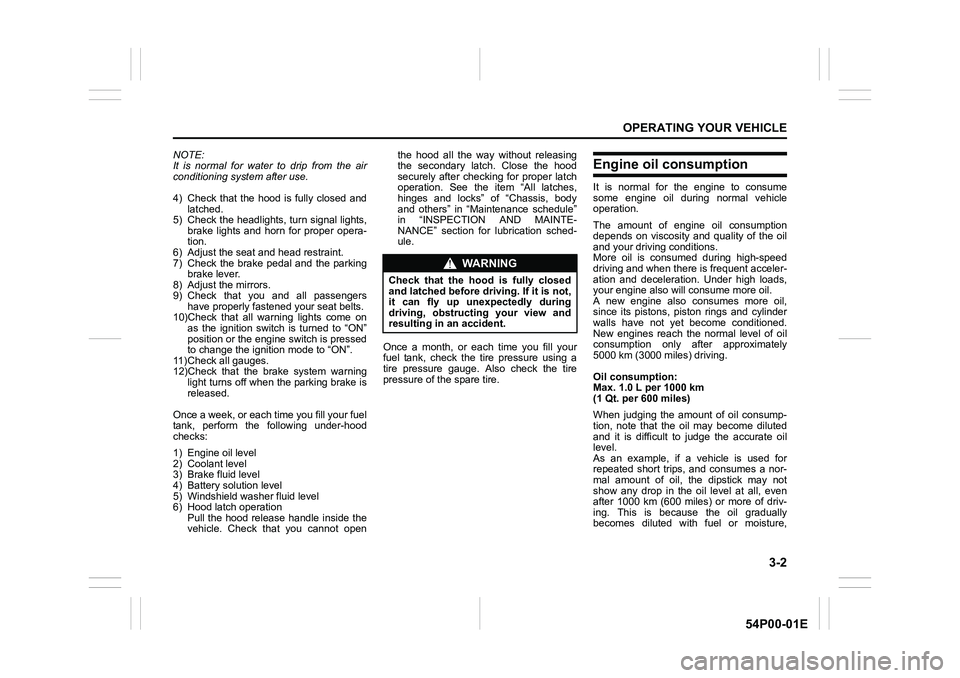
3-2
OPERATING YOUR VEHICLE
54P00-01E
NOTE:
It is normal for water to drip from the air
conditioning system after use.
4) Check that the hood is fully closed and
latched.
5) Check the headlights, turn signal lights,
brake lights and horn for proper opera-
tion.
6) Adjust the seat and head restraint.
7) Check the brake pedal and the parking
brake lever.
8) Adjust the mirrors.
9) Check that you and all passengers
have properly fastened your seat belts.
10)Check that all warning lights come on
as the ignition switch is turned to “ON”
position or the engine switch is pressed
to change the ignition mode to “ON”.
11)Check all gauges.
12)Check that the brake system warning
light turns off when the parking brake is
released.
Once a week, or each time you fill your fuel
tank, perform the following under-hood
checks:
1) Engine oil level
2) Coolant level
3) Brake fluid level
4) Battery solution level
5) Windshield washer fluid level
6) Hood latch operation
Pull the hood release handle inside the
vehicle. Check that you cannot openthe hood all the way without releasing
the secondary latch. Close the hood
securely after checking for proper latch
operation. See the item “All latches,
hinges and locks” of “Chassis, body
and others” in “Maintenance schedule”
in “INSPECTION AND MAINTE-
NANCE” section for lubrication sched-
ule.
Once a month, or each time you fill your
fuel tank, check the tire pressure using a
tire pressure gauge. Also check the tire
pressure of the spare tire.Engine oil consumption
It is normal for the engine to consume
some engine oil during normal vehicle
operation.
The amount of engine oil consumption
depends on viscosity and quality of the oil
and your driving conditions.
More oil is consumed during high-speed
driving and when there is frequent acceler-
ation and deceleration. Under high loads,
your engine also will consume more oil.
A new engine also consumes more oil,
since its pistons, piston rings and cylinder
walls have not yet become conditioned.
New engines reach the normal level of oil
consumption only after approximately
5000 km (3000 miles) driving.
Oil consumption:
Max. 1.0 L per 1000 km
(1 Qt. per 600 miles)
When judging the amount of oil consump-
tion, note that the oil may become diluted
and it is difficult to judge the accurate oil
level.
As an example, if a vehicle is used for
repeated short trips, and consumes a nor-
mal amount of oil, the dipstick may not
show any drop in the oil level at all, even
after 1000 km (600 miles) or more of driv-
ing. This is because the oil gradually
becomes diluted with fuel or moisture,
WA R N I N G
Check that the hood is fully closed
and latched before driving. If it is not,
it can fly up unexpectedly during
driving, obstructing your view and
resulting in an accident.
Page 153 of 482
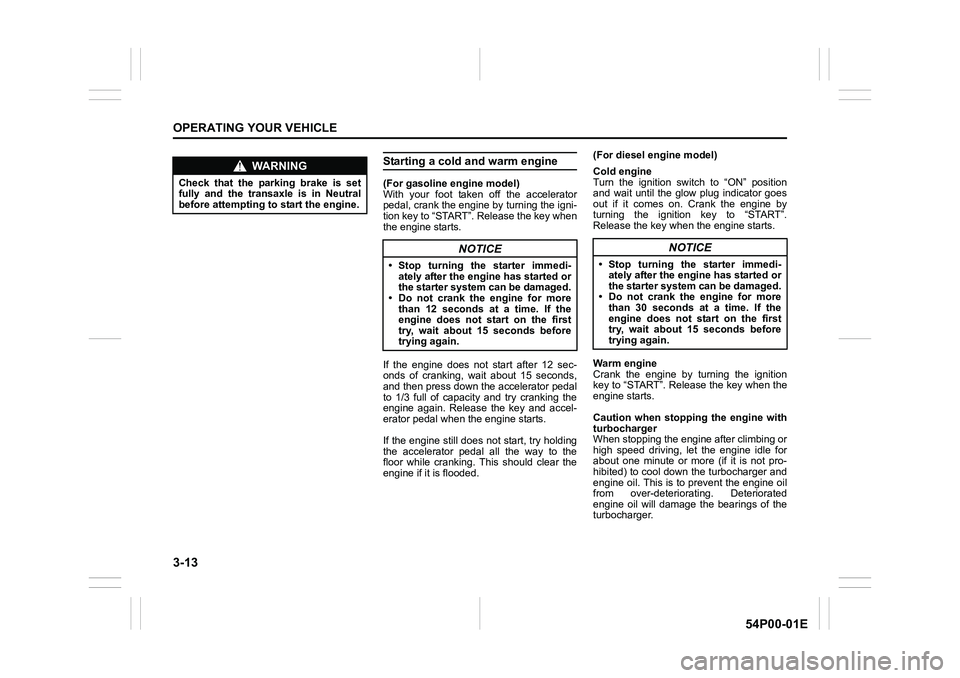
3-13
OPERATING YOUR VEHICLE
54P00-01E
Starting a cold and warm engine
(For gasoline engine model)
With your foot taken off the accelerator
pedal, crank the engine by turning the igni-
tion key to “START”. Release the key when
the engine starts.
If the engine does not start after 12 sec-
onds of cranking, wait about 15 seconds,
and then press down the accelerator pedal
to 1/3 full of capacity and try cranking the
engine again. Release the key and accel-
erator pedal when the engine starts.
If the engine still does not start, try holding
the accelerator pedal all the way to the
floor while cranking. This should clear the
engine if it is flooded.(For diesel engine model)
Cold engine
Turn the ignition switch to “ON” position
and wait until the glow plug indicator goes
out if it comes on. Crank the engine by
turning the ignition key to “START”.
Release the key when the engine starts.
Warm engine
Crank the engine by turning the ignition
key to “START”. Release the key when the
engine starts.
Caution when stopping the engine with
turbocharger
When stopping the engine after climbing or
high speed driving, let the engine idle for
about one minute or more (if it is not pro-
hibited) to cool down the turbocharger and
engine oil. This is to prevent the engine oil
from over-deteriorating. Deteriorated
engine oil will damage the bearings of the
turbocharger.
WA R N I N G
Check that the parking brake is set
fully and the transaxle is in Neutral
before attempting to start the engine.
NOTICE
• Stop turning the starter immedi-
ately after the engine has started or
the starter system can be damaged.
• Do not crank the engine for more
than 12 seconds at a time. If the
engine does not start on the first
try, wait about 15 seconds before
trying again.
NOTICE
• Stop turning the starter immedi-
ately after the engine has started or
the starter system can be damaged.
• Do not crank the engine for more
than 30 seconds at a time. If the
engine does not start on the first
try, wait about 15 seconds before
trying again.
Page 156 of 482
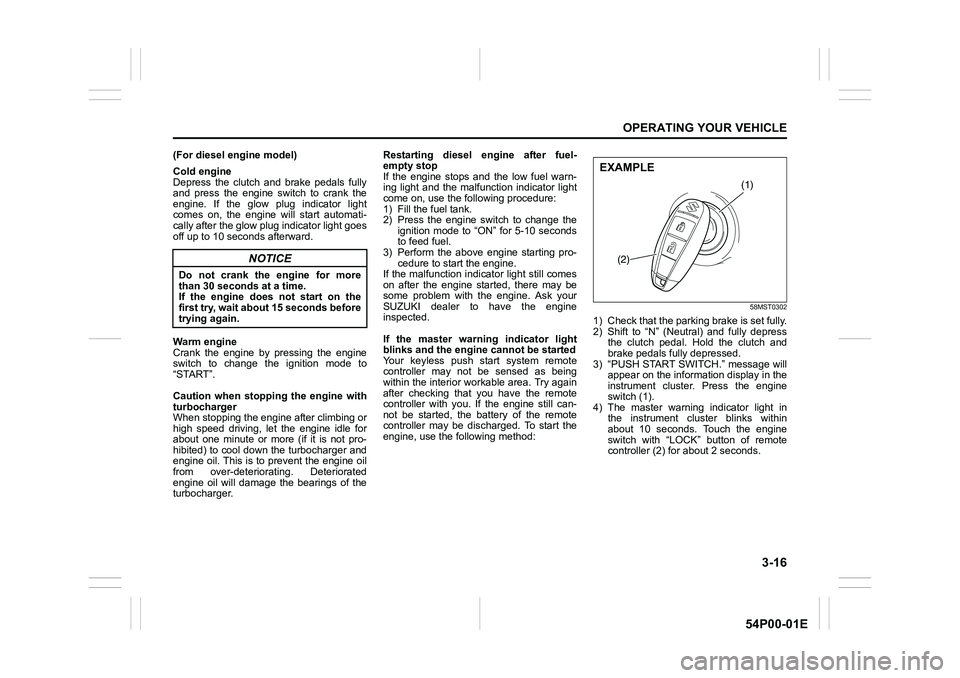
3-16
OPERATING YOUR VEHICLE
54P00-01E
(For diesel engine model)
Cold engine
Depress the clutch and brake pedals fully
and press the engine switch to crank the
engine. If the glow plug indicator light
comes on, the engine will start automati-
cally after the glow plug indicator light goes
off up to 10 seconds afterward.
Warm engine
Crank the engine by pressing the engine
switch to change the ignition mode to
“START”.
Caution when stopping the engine with
turbocharger
When stopping the engine after climbing or
high speed driving, let the engine idle for
about one minute or more (if it is not pro-
hibited) to cool down the turbocharger and
engine oil. This is to prevent the engine oil
from over-deteriorating. Deteriorated
engine oil will damage the bearings of the
turbocharger.Restarting diesel engine after fuel-
empty stop
If the engine stops and the low fuel warn-
ing light and the malfunction indicator light
come on, use the following procedure:
1) Fill the fuel tank.
2) Press the engine switch to change the
ignition mode to “ON” for 5-10 seconds
to feed fuel.
3) Perform the above engine starting pro-
cedure to start the engine.
If the malfunction indicator light still comes
on after the engine started, there may be
some problem with the engine. Ask your
SUZUKI dealer to have the engine
inspected.
If the master warning indicator light
blinks and the engine cannot be started
Your keyless push start system remote
controller may not be sensed as being
within the interior workable area. Try again
after checking that you have the remote
controller with you. If the engine still can-
not be started, the battery of the remote
controller may be discharged. To start the
engine, use the following method:
58MST0302
1) Check that the parking brake is set fully.
2) Shift to “N” (Neutral) and fully depress
the clutch pedal. Hold the clutch and
brake pedals fully depressed.
3) “PUSH START SWITCH.” message will
appear on the information display in the
instrument cluster. Press the engine
switch (1).
4) The master warning indicator light in
the instrument cluster blinks within
about 10 seconds. Touch the engine
switch with “LOCK” button of remote
controller (2) for about 2 seconds.
NOTICE
Do not crank the engine for more
than 30 seconds at a time.
If the engine does not start on the
first try, wait about 15 seconds before
trying again.
(1)
(2)
EXAMPLE
Page 158 of 482
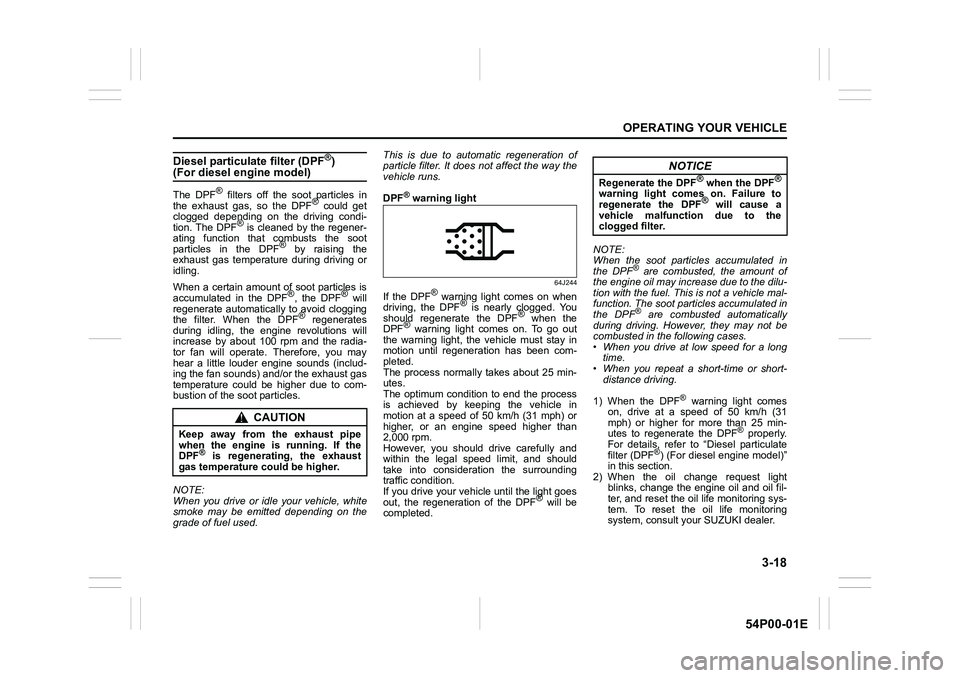
3-18
OPERATING YOUR VEHICLE
54P00-01E
Diesel particulate filter (DPF®) (For diesel engine model)
The DPF® filters off the soot particles in
the exhaust gas, so the DPF® could get
clogged depending on the driving condi-
tion. The DPF
® is cleaned by the regener-
ating function that combusts the soot
particles in the DPF
® by raising the
exhaust gas temperature during driving or
idling.
When a certain amount of soot particles is
accumulated in the DPF
®, the DPF® will
regenerate automatically to avoid clogging
the filter. When the DPF
® regenerates
during idling, the engine revolutions will
increase by about 100 rpm and the radia-
tor fan will operate. Therefore, you may
hear a little louder engine sounds (includ-
ing the fan sounds) and/or the exhaust gas
temperature could be higher due to com-
bustion of the soot particles.
NOTE:
When you drive or idle your vehicle, white
smoke may be emitted depending on the
grade of fuel used.This is due to automatic regeneration of
particle filter. It does not affect the way the
vehicle runs.
DPF
® warning light
64J244
If the DPF® warning light comes on when
driving, the DPF® is nearly clogged. You
should regenerate the DPF® when the
DPF® warning light comes on. To go out
the warning light, the vehicle must stay in
motion until regeneration has been com-
pleted.
The process normally takes about 25 min-
utes.
The optimum condition to end the process
is achieved by keeping the vehicle in
motion at a speed of 50 km/h (31 mph) or
higher, or an engine speed higher than
2,000 rpm.
However, you should drive carefully and
within the legal speed limit, and should
take into consideration the surrounding
traffic condition.
If you drive your vehicle until the light goes
out, the regeneration of the DPF
® will be
completed.NOTE:
When the soot particles accumulated in
the DPF
® are combusted, the amount of
the engine oil may increase due to the dilu-
tion with the fuel. This is not a vehicle mal-
function. The soot particles accumulated in
the DPF
® are combusted automatically
during driving. However, they may not be
combusted in the following cases.
• When you drive at low speed for a long
time.
• When you repeat a short-time or short-
distance driving.
1) When the DPF
® warning light comes
on, drive at a speed of 50 km/h (31
mph) or higher for more than 25 min-
utes to regenerate the DPF
® properly.
For details, refer to “Diesel particulate
filter (DPF
®) (For diesel engine model)”
in this section.
2) When the oil change request light
blinks, change the engine oil and oil fil-
ter, and reset the oil life monitoring sys-
tem. To reset the oil life monitoring
system, consult your SUZUKI dealer.
CAUTION
Keep away from the exhaust pipe
when the engine is running. If the
DPF
® is regenerating, the exhaust
gas temperature could be higher.
NOTICE
Regenerate the DPF® when the DPF®
warning light comes on. Failure to
regenerate the DPF® will cause a
vehicle malfunction due to the
clogged filter.
Page 159 of 482
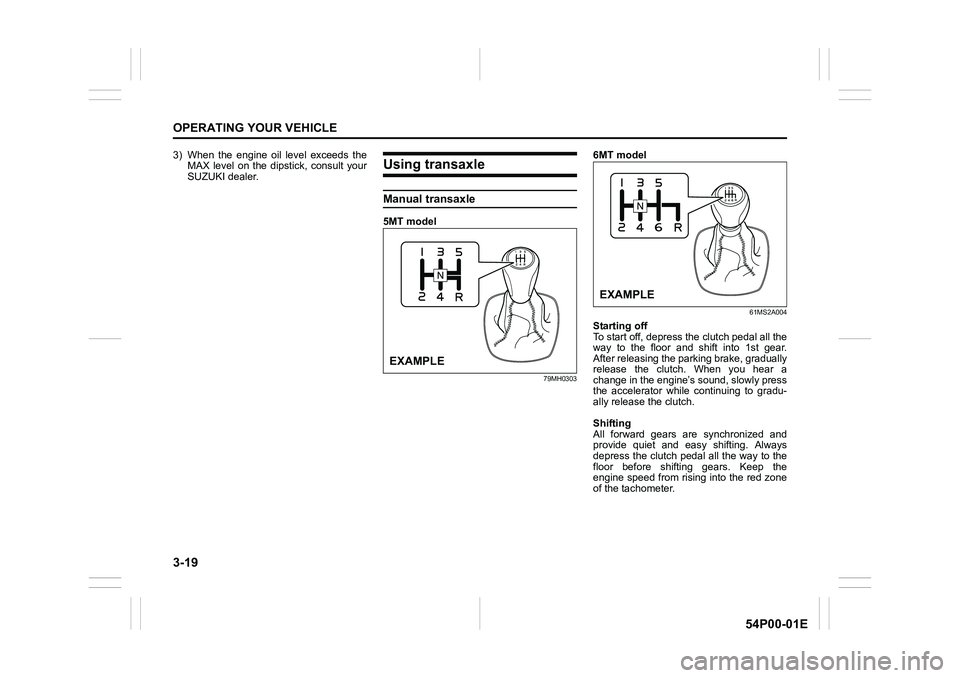
3-19
OPERATING YOUR VEHICLE
54P00-01E
3) When the engine oil level exceeds the
MAX level on the dipstick, consult your
SUZUKI dealer.Using transaxle
Manual transaxle
5MT model
79MH0303
6MT model
61MS2A004
Starting off
To start off, depress the clutch pedal all the
way to the floor and shift into 1st gear.
After releasing the parking brake, gradually
release the clutch. When you hear a
change in the engine’s sound, slowly press
the accelerator while continuing to gradu-
ally release the clutch.
Shifting
All forward gears are synchronized and
provide quiet and easy shifting. Always
depress the clutch pedal all the way to the
floor before shifting gears. Keep the
engine speed from rising into the red zone
of the tachometer.
EXAMPLE
EXAMPLE
Page 164 of 482
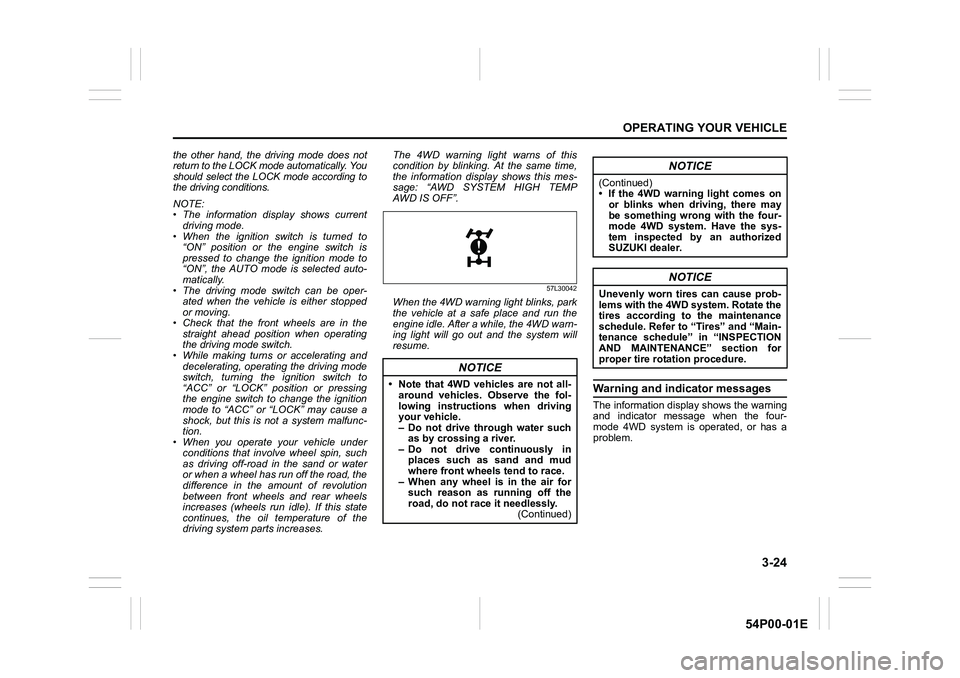
3-24
OPERATING YOUR VEHICLE
54P00-01E
the other hand, the driving mode does not
return to the LOCK mode automatically. You
should select the LOCK mode according to
the driving conditions.
NOTE:
• The information display shows current
driving mode.
• When the ignition switch is turned to
“ON” position or the engine switch is
pressed to change the ignition mode to
“ON”, the AUTO mode is selected auto-
matically.
• The driving mode switch can be oper-
ated when the vehicle is either stopped
or moving.
• Check that the front wheels are in the
straight ahead position when operating
the driving mode switch.
• While making turns or accelerating and
decelerating, operating the driving mode
switch, turning the ignition switch to
“ACC” or “LOCK” position or pressing
the engine switch to change the ignition
mode to “ACC” or “LOCK” may cause a
shock, but this is not a system malfunc-
tion.
• When you operate your vehicle under
conditions that involve wheel spin, such
as driving off-road in the sand or water
or when a wheel has run off the road, the
difference in the amount of revolution
between front wheels and rear wheels
increases (wheels run idle). If this state
continues, the oil temperature of the
driving system parts increases. The 4WD warning light warns of this
condition by blinking. At the same time,
the information display shows this mes-
sage: “AWD SYSTEM HIGH TEMP
AWD IS OFF”.
57L30042
When the 4WD warning light blinks, park
the vehicle at a safe place and run the
engine idle. After a while, the 4WD warn-
ing light will go out and the system will
resume.
Warning and indicator messages
The information display shows the warning
and indicator message when the four-
mode 4WD system is operated, or has a
problem.
NOTICE
• Note that 4WD vehicles are not all-
around vehicles. Observe the fol-
lowing instructions when driving
your vehicle.
– Do not drive through water such
as by crossing a river.
– Do not drive continuously in
places such as sand and mud
where front wheels tend to race.
– When any wheel is in the air for
such reason as running off the
road, do not race it needlessly.
(Continued)
NOTICE
(Continued)
• If the 4WD warning light comes on
or blinks when driving, there may
be something wrong with the four-
mode 4WD system. Have the sys-
tem inspected by an authorized
SUZUKI dealer.
NOTICE
Unevenly worn tires can cause prob-
lems with the 4WD system. Rotate the
tires according to the maintenance
schedule. Refer to “Tires” and “Main-
tenance schedule” in “INSPECTION
AND MAINTENANCE” section for
proper tire rotation procedure.
Page 280 of 482
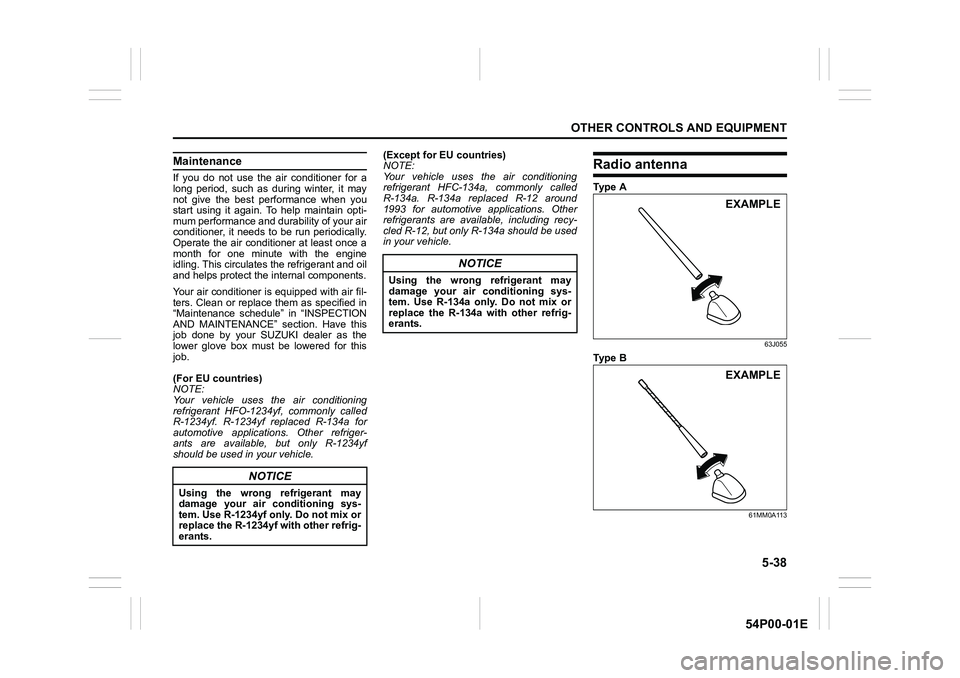
5-38
OTHER CONTROLS AND EQUIPMENT
54P00-01E
Maintenance
If you do not use the air conditioner for a
long period, such as during winter, it may
not give the best performance when you
start using it again. To help maintain opti-
mum performance and durability of your air
conditioner, it needs to be run periodically.
Operate the air conditioner at least once a
month for one minute with the engine
idling. This circulates the refrigerant and oil
and helps protect the internal components.
Your air conditioner is equipped with air fil-
ters. Clean or replace them as specified in
“Maintenance schedule” in “INSPECTION
AND MAINTENANCE” section. Have this
job done by your SUZUKI dealer as the
lower glove box must be lowered for this
job.
(For EU countries)
NOTE:
Your vehicle uses the air conditioning
refrigerant HFO-1234yf, commonly called
R-1234yf. R-1234yf replaced R-134a for
automotive applications. Other refriger-
ants are available, but only R-1234yf
should be used in your vehicle.(Except for EU countries)
NOTE:
Your vehicle uses the air conditioning
refrigerant HFC-134a, commonly called
R-134a. R-134a replaced R-12 around
1993 for automotive applications. Other
refrigerants are available, including recy-
cled R-12, but only R-134a should be used
in your vehicle.
Radio antenna
Ty p e A
63J055
Ty p e B
61MM0A113
NOTICE
Using the wrong refrigerant may
damage your air conditioning sys-
tem. Use R-1234yf only. Do not mix or
replace the R-1234yf with other refrig-
erants.
NOTICE
Using the wrong refrigerant may
damage your air conditioning sys-
tem. Use R-134a only. Do not mix or
replace the R-134a with other refrig-
erants.
EXAMPLE
EXAMPLE
Page 338 of 482
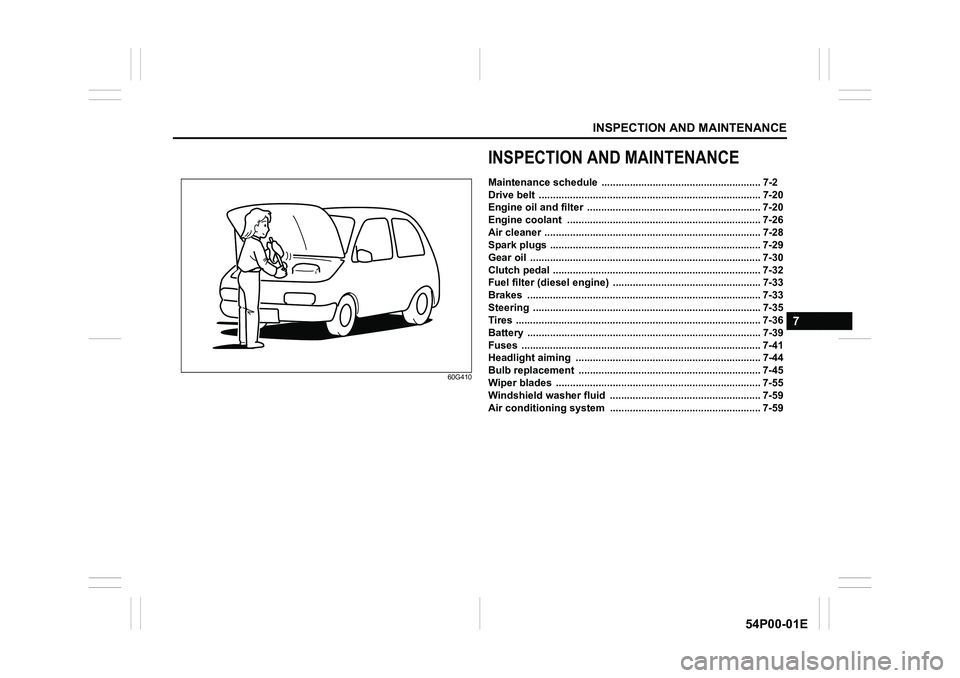
INSPECTION AND MAINTENANCE
7
54P00-01E
60G410
INSPECTION AND MAINTENANCE
Maintenance schedule ........................................................ 7-2
Drive belt .............................................................................. 7-20
Engine oil and filter ............................................................. 7-20
Engine coolant .................................................................... 7-26
Air cleaner ............................................................................ 7-28
Spark plugs .......................................................................... 7-29
Gear oil ................................................................................. 7-30
Clutch pedal ......................................................................... 7-32
Fuel filter (diesel engine) .................................................... 7-33
Brakes .................................................................................. 7-33
Steering ................................................................................ 7-35
Tires ...................................................................................... 7-36
Battery .................................................................................. 7-39
Fuses .................................................................................... 7-41
Headlight aiming ................................................................. 7-44
Bulb replacement ................................................................ 7-45
Wiper blades ........................................................................ 7-55
Windshield washer fluid ..................................................... 7-59
Air conditioning system ..................................................... 7-59